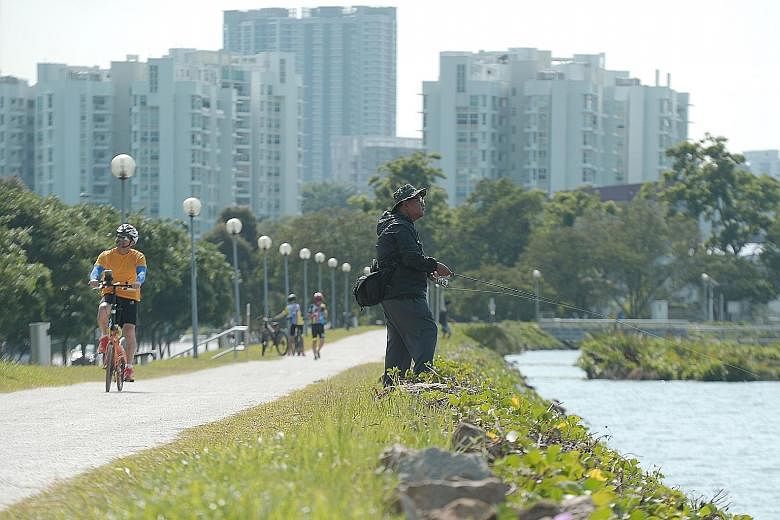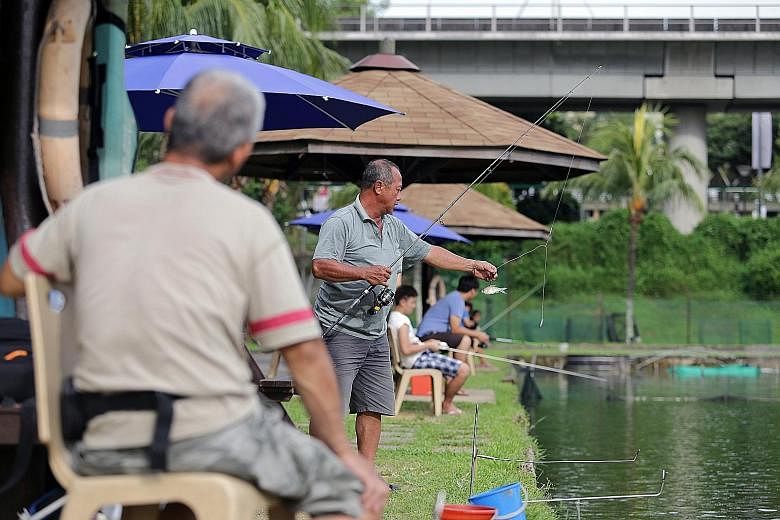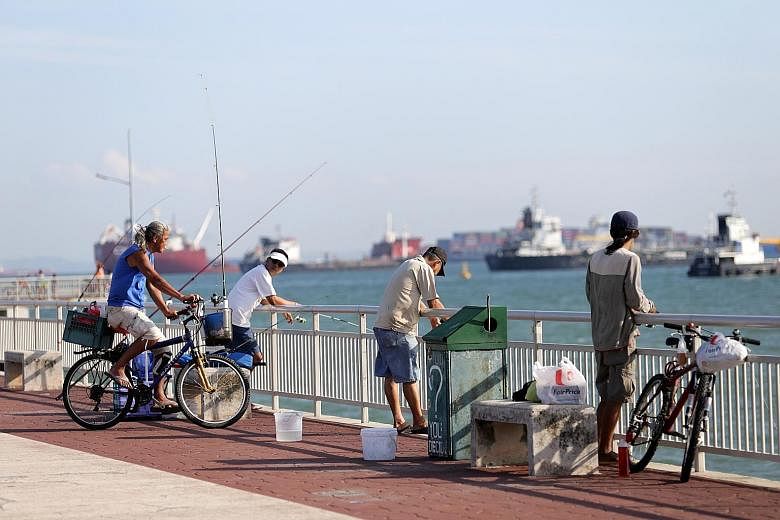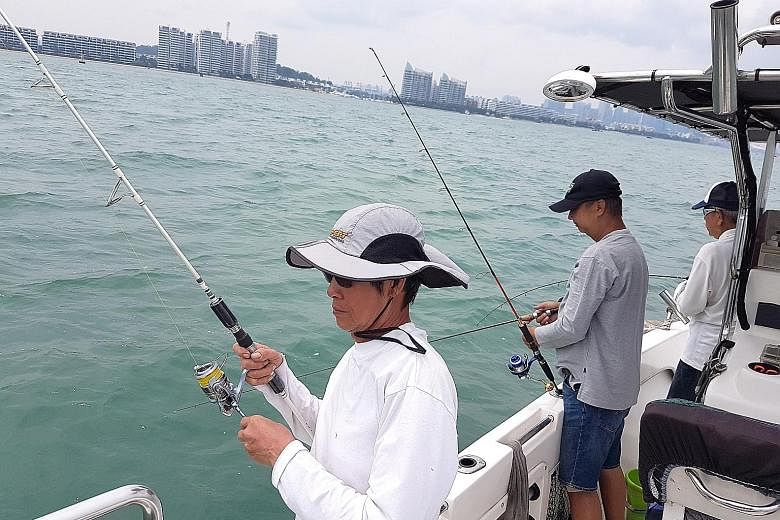More Singaporeans are getting hooked on fishing.
The age-old activity has been attracting a wider demographic - younger people and families - with the introduction of different fishing techniques and new fishing spots islandwide, including new ones permitted by the authorities such as Geylang River, Pelton Canal and Rochor Canal.
There are a variety of options catering to different levels of expertise. Beginners can start at pay ponds, where they pay by the hour to fish at an artificial pond.
Intermediates can fish at designated spots such as jetties and reservoirs, while the experienced often charter boats to fish in open waters.
Mr Luke Cunico, 39, who runs Singapore angling forum Fishing Kaki, notes that the number of its users has doubled to 450,000 in the past three years.
This is because fishing is getting easier with artificial bait, or lures.
"Lures generally are ready to go, unlike live bait which needs some preparation," he says.
These lures come in a variety of shapes, sizes, colours and textures, and are meant to imitate prey. Some look like small fish made out of plastic or wood, others mimic bugs and some evoke little birds and are adorned with feathers.
Artificial baits have made fishing more active. In the past, a fisherman simply cast a line and waited for hours for a fish to bite. With a lure, the angler has to keep moving the bait in the water.
If there is no catch after a while, he will move on to another area and see if other types of fish are attracted to the lure.
"It's not just about luck any more," says Ms Doris Toh, chief executive of home-grown company SureCatch World, a wholesaler, exporter and manufacturer of fishing tackle equipment.
She says sales of sport fishing tackles have risen 20 per cent in the past three years because the activity has become "more exciting".
As a result, a new breed of anglers in their teens and 20s are picking it up.
Product manager Lewis Ang, 29, started fishing at the age of 13 out of "pure boredom" and has been hooked since.
Once a week, he heads to pay ponds or reservoirs to fish. About five times a year, he goes on overseas fishing trips with fellow anglers to nearby countries such as Malaysia, Indonesia and Thailand.
He uses only artificial lures as he cannot stand the thought of standing at one spot and waiting.
"I prefer the thrill of hunting and figuring out the best ways to catch fish," he says.
Meanwhile, Ms Toh, an avid angler herself, also hopes to reach out to non-anglers and families.
After encouraging her 13-year-old son to put away his gadgets and take up fishing last year, she noticed it had brought them closer. "I realised fishing makes for an ideal family- bonding activity too," she says.
She then got the idea to start a group that newbies and families could reach out to if they wanted to learn more about fishing, so she set up the SportFishing Federation Singapore in May this year.
Still in its early stages, the federation has held a few fishing and prawning clinics, and has plans to do so on a regular basis.
The number of fishing spots has increased over the years too, with at least 23 legal places in Singapore.
Earlier this month, national water agency PUB opened up four new fishing areas under a one-year trial. This is to "raise awareness of the need to share common spaces and promote responsible fishing while catering to the growing interest in recreational fishing", says Mr Ridzuan Ismail, PUB's director of catchment and waterways.
The new spots have been set up along Geylang River, Pelton Canal, Rochor Canal and Kolam Ayer ABC Waterfront at Kallang River.
Besides reservoirs and waterways, anglers can also fish at designated jetties such as Bedok Jetty and Lower Seletar Reservoir Park's fishing jetty. Anglers can fish only within the designated areas and use artificial bait which does not pollute the water.
The authorities encourage people to practise catch-and-release, though there are no laws against anglers who keep their catch.
Full-time angler Bone Lim, 36, says "the designated areas aren't the best places for us to fish".
As such, he regularly heads overseas to Malaysia, Thailand, China and Australia.
This is a pity, says Ms Toh, as there are exotic varieties of fish in Singapore waters that could attract anglers from abroad.
One example is the black-striped peacock bass, a highly sought-after freshwater fish that many recreational anglers travel to Brazil's Amazon Basin to catch.
"More can be done to make it a lifestyle activity and make it more family- and tourist-friendly," she says.
These limitations are not stopping anglers though.
Businesswoman Elim Chew, 50, entered the fishing game recently.
The opportunity arose last Christmas when she visited a pay pond, and with the help of experienced anglers, picked up the activity. Ms Chew now fishes almost every weekend at D'Best Fishing, a pay pond in Pasir Ris. She also makes overseas trips to places such as Malaysia and Thailand.
On her trips abroad, she says: "There is the thrill of getting the catch and dealing with unpredictable weather.
"And on the other hand, it is therapeutic too as it's just you, the fish and the waters out in the open."
Reservoirs and waterways
Fishing is permitted at 15 designated spots islandwide and the locations include Bedok Reservoir, Lower Seletar Reservoir and Rochor Canal.
Earlier this month, national water agency PUB opened up four new fishing areas under a one-year trial. They are along Geylang River, Pelton Canal, Rochor Canal and Kolam Ayer ABC Waterfront at Kallang River.
Fishermen have to use artificial bait and are encouraged to practise catch-and-release fishing. This means that after landing the fish, anglers should unhook and return their catch to the water.
Fish found in these waters include grouper, marble goby (or soon hock in dialect) and the highly prized peacock bass native to the Amazon Basin.
Customer service officer Joey Chan, 26, often fishes in reservoirs, but bemoans the "lack of variety". Still, she finds it more convenient than heading out to sea.
"Going out to sea on a boat takes a day, while it takes only a few hours to try my luck at a reservoir," she says.
Pay ponds
If you are new to fishing, pay ponds are a good place to start.
Pay ponds are commercial areas where you pay by the hour to fish at ponds. At most of these places, fishing rods and bait are provided.
There are several pay ponds in Singapore in areas such as Punggol, East Coast Park, Khatib and Pasir Ris.
At Fishing Paradise at Orto leisure park in Lorong Chencharu, there is a small beginner's pond where budding anglers will definitely hook a catch within five minutes, says its events director Edmund Kong.
"We want to give beginners a taste of fishing where they catch something rather than going to the jetty or sea and catching either nothing or very small fish," he says.
Rates start at $5 a catch in the beginner's pond and $12 an hour or $60 for a whole day at the main pond.
Fishing Paradise has close to 20 types of fish such as peacock bass, red tail catfish and toman.
Copy editor Andrew Tan, 48, was at Fishing Paradise two weekends ago to teach his six-year-old son Joshua how to fish.
"Joshua enjoys it as he manages to catch fish and it's a safe environment," he says.
Some pay ponds are also popular with experienced fishermen as they are open all hours of the day.
D'Best Fishing in Pasir Ris operates 24 hours a day and rates start at $40 for a 10-hour off-peak block in the main pond.
"There are higher chances of a catch as a truckload of fish is released daily into the pond," says the pond's director Darren Seng.
The pond fish include golden snapper, mangrove jack and promfret.
Jetties and waterfront parks
One of the most conspicuous fishing spots in Singapore is the 250m-long Bedok Jetty in East Coast Park.
Lines of fishing rods are perched along the boardwalk, while experienced anglers sit behind them for hours and wait patiently.
Seasoned fishermen say that jetties are the next best thing to heading out to sea for a more challenging angling experience as the waters are deep.
Another designated fishing jetty is the one at Lower Seletar Reservoir Park.
The jetty can be an intimidating place for beginners, however, as many of the fishermen there are very experienced.
However, they are more than happy to give advice or lend a hand.
Retiree Patrick Tan, 70, has been a regular at the jetty for more than 30 years. He uses two rods and also several styrofoam boxes to hold small fish as live bait and his catch.
"There are so many types of fish," he says, before rattling off examples of species he has caught: catfish, chermin, barracuda, stingray, squid and even sharks.
His biggest catch so far was a whopping 10kg leopard stingray two years ago.
Besides fishing from jetties, anglers can also go to the shores of waterfront parks.
The National Parks Board has a list of approved areas on its website and the list includes Changi Beach Park and Bedok Reservoir Park.
Offshore islands
Fishing in the open seas is more difficult than at reservoirs or pay ponds, but the deeper waters also yield a greater variety of catch.
In Singapore, anglers can charter a boat out to the waters around Changi, Pulau Ubin and the Southern Islands.
On the northern side where Pulau Ubin is, there are mangrove jack, stingray and leatherjacks.
In the waters around the Southern Islands, there are parrot fish, cobia, golden snapper and Spanish flag snapper.
Unlike at Pulau Ubin, anglers can fish from the open waters, but not from the islands themselves.
Companies such as Deep Sea Fishing offer day tours from $65 a person with a fishing guide on board.
There are also independent operators such as Mr William Chan, 43, an avid angler and owner of Fishing Buddy, a fishing tackle store with three outlets in Toa Payoh, Marine Parade and Jurong.
He takes customers out on a boat to the Southern Islands 10 to 15 times a month.
"It's nice to get out of Singapore with friends," he says.




